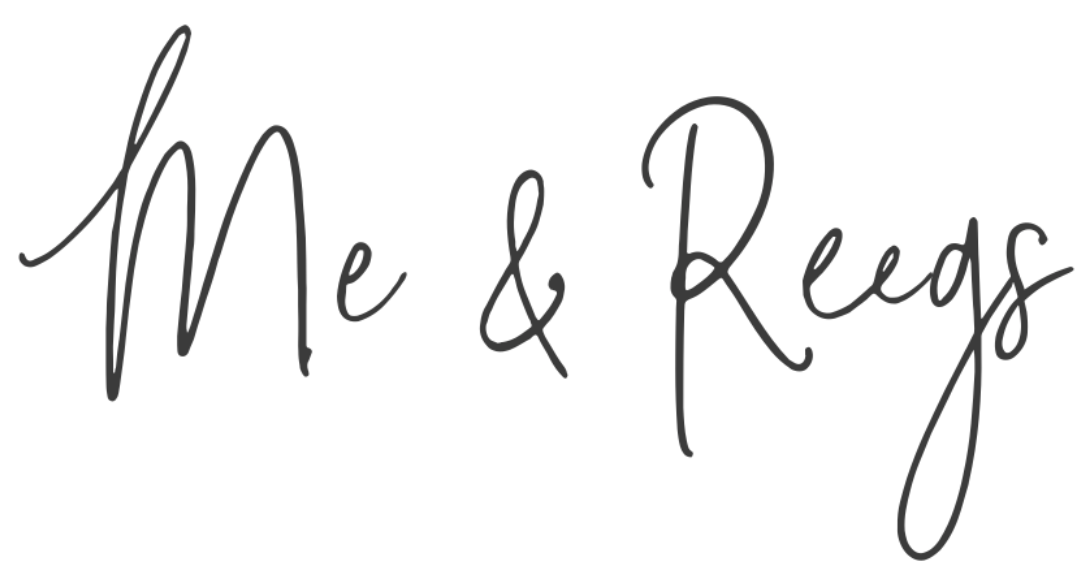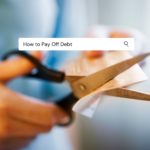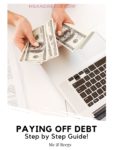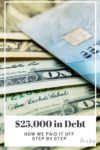We paid off $25,000~ in credit card debt in one year. We have decided to share how we did it to help and encourage others in similar spots. It’s possible. It’s hard. It stinks. It’s so worth it.
I am not a financial advisor; others shared resources with me, and I want to pass those resources on to more people. Debt (heck, money in general) can feel VERY lonely. As you go through this process, remind yourself that unfortunately, consumer debt is common. On average, Americans carry a revolving $7,000 in credit card debt; with a national total of over $416.13 Billion. Also, know that you don’t have to live like this anymore. Freeing yourself from credit card debt is an incredible feeling.
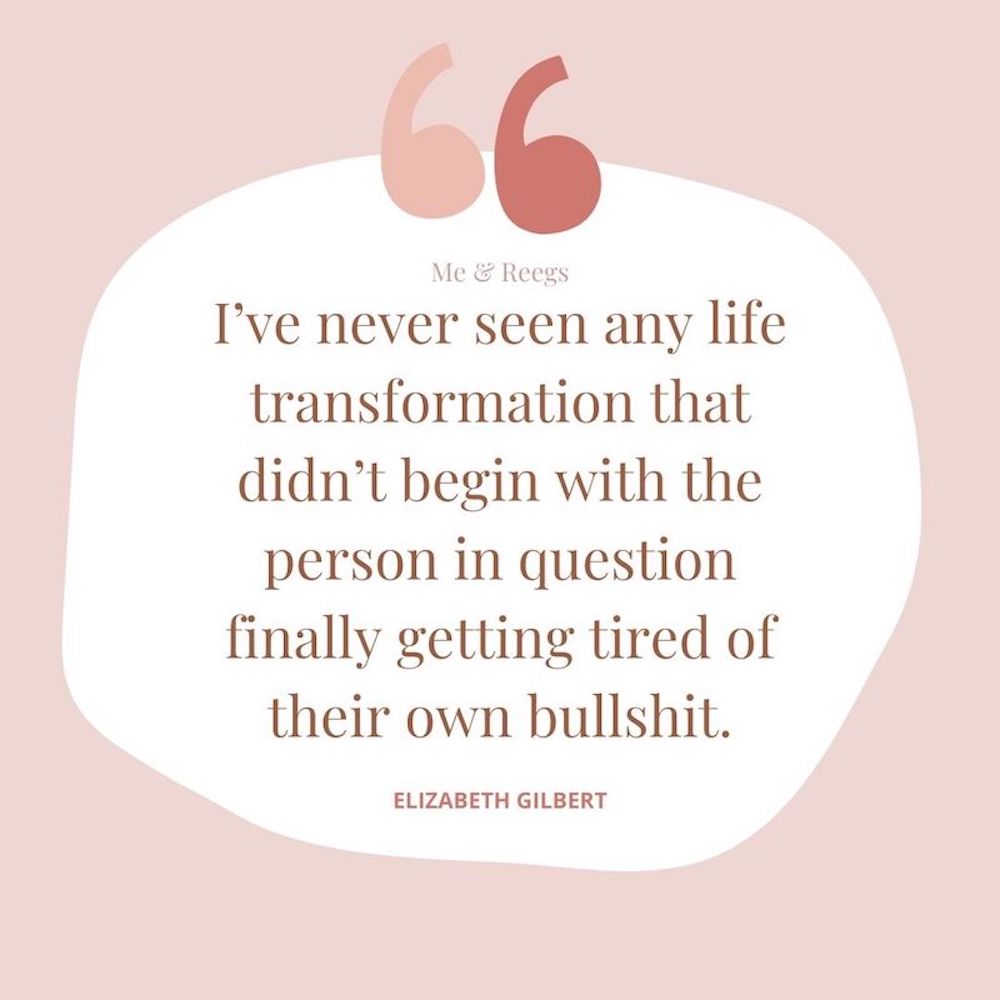
How Our Credit Card Debt Came to a Head:
In 2018, a few years into our marriage (with now two babies), our banking accounts were still separate. I could feel Jeff wake up in the middle of the night and just lay eyes wide open in the dark on a regular basis. I knew deep down what it was; I tried hard to ignore it. Mainly because I didn’t know the solution. Not knowing a solution made me feel guilty and honestly, dumb. I always told myself I wasn’t good with money. I also told myself, “It can’t be that bad. He’s dramatic sometimes.” Until one day, I woke up with the same feeling. I had racked up about $5,000 on my personal credit card and I wasn’t sure how I was going to pay it off running against the interest rate without stressing Jeff out.
We had gotten married, had kids, moved internationally, bought our first house, furnished a home for the first time… things added up.
I knew what we were slowly doing to our marriage. For us, keeping our finances separate, we thought we were putting less financial strain on our family. But really we were going through separately, what we should’ve been going through together.
Every time I spent money, and he felt stressed about payments; I was unknowingly stabbing a knife in a wound.
Every time I panicked about wanting more financial success, and he told me to calm down and enjoy being a stay at home mom; I was secretly worried I was about to disappoint him.
Things needed to change.
It was time to face the music and fix our debt situation. I started following financial accounts, no spend challenges, reading books about money, and minimalism. Before I approached Jeff, I got serious.
I called Jeff into our home office and pulled out the wipe-off board. I told him it was time to face our credit card debt. To say he was uncomfortable is an understatement.
Jeff is a provider. He wants nothing more than to give his family everything. As much as I was worried to disappoint him, he was afraid to disappoint me.
There are A LOT of feelings when it comes to money.
What is Money Noise?
Money Noise is within all of us. Whether we think there is an unlimited river of money flowing to us, or we think it’s a pie that we are clawing our way to a sliver of, there is a dialogue about money deep in our subconscious.
My money noise was 1. If you don’t talk about it, it’ll be fine. Some day. Probably. And 2. I will never have “enough” because I’m not worth much. (Bleak. I know that now)
Bleak money noise keeps us a prisoner. It keeps us from leveling up. It keeps us from being honest with people we love. It probably comes from your family not having much, or your self worth struggling. If you are battling money noise, admitting that will be your first step. Get your gloves on, because it’s a long, hard fight.
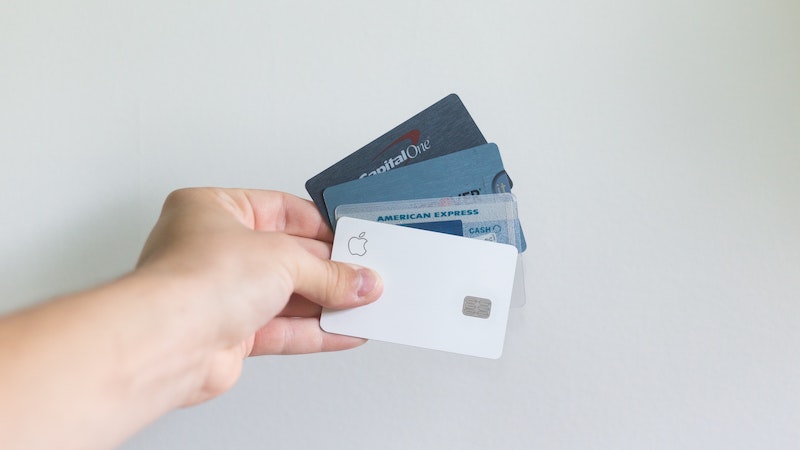
How We Tackled Our Credit Card Debt:
Step 1: Face the Numbers as a Whole.
We logged into every account one by one and started adding things up. $1,000 on Target. $17,000 on Bank of America. $3,000 on Amex. The list went on. I had no idea this is where we were. I felt awful that he had been facing this alone while I talked about curtains and gymnastics classes.
My guilt hit me like a wave. It was also the pill I needed to swallow. When we finally came to our total number, it was a lot easier to talk about why he needed to stop grabbing lunch at work and why maybe I didn’t need to try a new skincare product.
When debt is sprinkled here and there, it never seems as bad. When you add it up, you know what you are looking at. When you add it up, you can also see it dissolve as you go.
Step 2: Write it Somewhere Visible.
I love a spreadsheet. We used an excel sheet to track our progress. However, you need that number in your face. We wrote our debt total on the office wipe-off board. You can write it on your mirror, your fridge. But make it somewhere you look at constantly.
Don’t erase the big number as you go. Looking at your progress as you chip away is powerful. Leave that starting number at the top and put your progress number underneath it.
Step 3: Find the Leaks
We went through our statements and found all of the leaks. Leaks sink ships. Add up those lunches out, the coffee, the alcohol bills, the extra business course, the makeup you bought when you had a similar product, the highlights, the Home Depot trips, the snacks you don’t need in your grocery cart, the streaming services. Find them all. Cut back. This isn’t forever. You will go to Chipotle again one day. You will add Gauc. You will be fine. But scaling back for a few months is another card payment. It’s finding your way to freedom faster. It’s also seeing what you can live without. (Hint: a ton of it)
Step 4: Use NerdWallet to find a No Interest Card without Transfer Fees.
Controversial with many famous money coaches – This step was our saving grace. Running after interest rates, no matter how low they are, can be impossible. You can do it, but it’s much faster to get at least a chunk of the debt to a card with zero interest. NerdWallet will give you options. Watch out for balance transfer fees (3% adds up).
Write down the date that your new card will start interest on. Make sure you know if that interest with be charged on the beginning balance or the balance at that date. That card needs to paid off before that date. Write that somewhere visible as well.
Step 5: Start the Debt Snowball
Dave Ramsey lives and dies by paying your credit card debt off with the debt snowball method. Within the debt-free community, there are different views on this The Simple Path to Wealth is against it. JL Collins argues this process is not supposed to feel comfortable. I will second the snowball.
What is a Debt Snowball?
A debt snowball is paying the lowest totaling credit card to the highest. You may want to make the bigger number disappear first, especially chasing interest, but knocking cards off one by one is motivational. You see things moving quickly. You get to cut things up.
This is why I put the higher number on the new zero-interest card. It allowed me to attack cards like Target, with high-interest rates, while the big Bank of America card was on ice.
What does this mean for my budget?
It’s not fun, but every dollar not assigned to your bills/basics is a dollar towards your debt. If I sold something on eBay for $10, I made an immediate $10 payment to the card. I did not wait to make big chunk payments at once at the end of the month. Our debt was paid with the minimum monthly payments we had budgeted for, combined with $5-200+ payments as money came in. That’s how it added up, and that’s how it went away.
We’re talking, I rolled our change and put that to the card. No penny was left behind.
We also picked a buffer number within our checking account and at the end of the month, anything over that number went to the debt. Even if it was $13.70. You better believe that .70 was included.
We took every credit card out of our wallets and cut up the cards as we paid them off.
Step 6: Make More Money & Sell Everything.
While paying off this debt I worked 4+ jobs as a stay at home mom. Yes. FOUR. I worked for a PR firm, got a weekend job at Ann Taylor, was part of an MLM company, and made a commission from sales on my blog. I was exhausted. I was often up until 2 am working. I would schedule emails at 2 am to send out around 8-10 am so I didn’t look insane.
I picked up odds and end freelance jobs along the way; crafting emails for people, designing business cards on Etsy… you name it.
If you used a link, bought a product, or employed me during this time, you will never know how much it helped us.
Jeff makes what he makes. There is no overtime, no bonuses. So anything we wanted outside of the lines of his paycheck, I was going to need to do it.
We listed things on eBay while watching TV at night. Everything from our childhood toys to clothing we weren’t using. This is where decluttering also came into play. I read The More of Less by Joshua Becker and watched Marie Kondo on Netflix. Everything we decided to purge was sold.
Every paycheck was dedicated to a card payment when it hit my account. I wrote my paydays in my calendar and wrote incoming money amounts on the wipe-off board.
Step 7: Do Not Give Up.
You got this. You might be saying I have nothing to sell, I already work all night… Add it up, work with the banks, chip at it dollar by dollar. Just the way you got there. You will get out.
Follow Instagram accounts with the hashtag #DebtFreeCommunity. These are people working their way through Dave Ramsey. They are not millionaires who got lucky. They are you and me. They are cheering each other on for an extra $25 payment.
Listen to the audiobooks listed below (your local library has them on the Libby app) to encourage you. We will all forever remember that March 14th is Pi Day, but many of us have never been taught the basics of compounding interest, retirement, and investing. Knowledge is power. Educating yourself during this process instead of beating yourself up, sets you up for a magical future.
Speak “I’m going to be debt-free” into the universe. Friends are also on this path. They will cheer you on. I will cheer you on! DM me if you need friendly encouragement.
Our approach was to go as fast as we could without it feeling like a fasting diet. Just like learning to eat healthily, we cut the junk out, made as many good choices as we could, and kept our foot on the gas. That may be your approach, or you may change speeds as you go.
Celebrate your progress at every step. What you are doing is such a beautiful gift to your future self.
Our Favorite Books About Money
- The Millionaire Next Door by Thomas J. Stanley. This is the OG book about money. Before Dave Ramsey, there was The Millionaire Next Door. My kids will be forced to read this book one day. At 33, this book changed my outlook on our retirement and long term plan.
- The Simple Path to Wealth by JL Collins. Perfectly practical. The Simple Path to Wealth focuses on Financial Freedom. The goal is to have enough saved and invested that you can live off of the 4% interest per year. Your F-U money. If that’s 40k a year, you need a million invested. And the number one killer of that goal? Debt. JL Collins differs from Dave Ramsey in his view on the debt snowball. He says to write down your debts, pay each minimum, and then attack by interest rates. Highest to lowest. He also dives into investing with Vanguard; simplifying it and making investing not a big scary idea. Vanguard is another BFF of mine.
- The Total Money Makeover by Dave Ramsey. It took me a long time to be ready for Dave Ramsey. He feels a lot like a dad yelling at you for making bad choices. When I was really ready to make moves, I was ready for his intensity. I listened to The Total Money Makeover on Audible. His following is thick as thieves. His #DebtFreeCommunity crew is strong on social media. I suggest following them and joining their Facebook groups to balance out the influencer try-ons (stop watching those) and beautiful home decor.
- Smart Women Finish Rich by David Bach. David Bach gets a lot of flack on social media for his latte theory. Invest $5 a day instead of grabbing a Starbucks coffee. It’s a privileged approach. However, his point is looking for the leaks no matter how small. David Bach spoke to me in a way that translated. He introduced me to extra mortgage payments and made me fall in love with amortization calculators.
